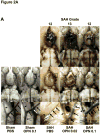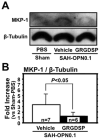Recombinant osteopontin in cerebral vasospasm after subarachnoid hemorrhage
- PMID: 21031580
- PMCID: PMC2967465
- DOI: 10.1002/ana.22102
Recombinant osteopontin in cerebral vasospasm after subarachnoid hemorrhage
Abstract
Objective: Osteopontin (OPN), a pleiotropic extracellular matrix glycoprotein, has been reported to be protective against ischemic lesions, but effects of OPN on vascular functions have not been investigated. The aim of this study was to assess whether recombinant OPN (r-OPN) could prevent cerebral vasospasm after subarachnoid hemorrhage (SAH) in rats.
Methods: r-OPN was administered intraventricularly to rats undergoing SAH by endovascular perforation, and its protective effects were evaluated by measuring the diameter of cerebral arteries and neurobehavioral testing. Western blotting and immunofluorescence were performed to explore the underlying mechanisms. An integrin receptor antagonist GRGDSP or mitogen-activated protein kinase (MAPK) phosphatase (MKP)-1 small interfering RNA (siRNA) was also administered to r-OPN-treated SAH rats, and those effects were evaluated.
Results: Pre-SAH administration of r-OPN prevented vasospasm and neurological impairments at 24-72 hours post-SAH. r-OPN enhanced an endogenous MAPK inhibitor, MKP-1, and suppressed the phosphorylation of MAPKs, caldesmon, and heat shock protein 27 in the spastic cerebral arteries at 24 hours post-SAH. Immunofluorescence revealed that MKP-1 was induced in the arterial smooth muscle layer. GRGDSP prevented r-OPN-induced MKP-1 upregulation, and MKP-1 siRNA abolished both MAPK inactivation and anti-vasospastic effects by r-OPN. Post-SAH r-OPN treatment also prevented vasospasm.
Interpretation: r-OPN induced MKP-1 in the spastic cerebral arteries via binding to L-arginyl-glycyl-L-aspartate-dependent integrin receptors and prevented vasospasm after SAH. Therapeutic induction of MKP-1 may be a novel approach for the prevention and treatment of cerebral vasospasm.
Figures







Similar articles
-
Recombinant osteopontin attenuates experimental cerebral vasospasm following subarachnoid hemorrhage in rats through an anti-apoptotic mechanism.Brain Res. 2015 Jun 22;1611:74-83. doi: 10.1016/j.brainres.2015.03.015. Epub 2015 Mar 14. Brain Res. 2015. PMID: 25779039
-
Mechanisms of osteopontin-induced stabilization of blood-brain barrier disruption after subarachnoid hemorrhage in rats.Stroke. 2010 Aug;41(8):1783-90. doi: 10.1161/STROKEAHA.110.586537. Epub 2010 Jul 8. Stroke. 2010. PMID: 20616319 Free PMC article.
-
Recombinant Osteopontin Stabilizes Smooth Muscle Cell Phenotype via Integrin Receptor/Integrin-Linked Kinase/Rac-1 Pathway After Subarachnoid Hemorrhage in Rats.Stroke. 2016 May;47(5):1319-27. doi: 10.1161/STROKEAHA.115.011552. Epub 2016 Mar 22. Stroke. 2016. PMID: 27006454 Free PMC article.
-
Current perspective on the role of the thrombin receptor in cerebral vasospasm after subarachnoid hemorrhage.J Pharmacol Sci. 2010;114(2):127-33. doi: 10.1254/jphs.10r03cp. Epub 2010 Sep 17. J Pharmacol Sci. 2010. PMID: 20859063 Review.
-
Therapeutically Targeting Platelet-Derived Growth Factor-Mediated Signaling Underlying the Pathogenesis of Subarachnoid Hemorrhage-Related Vasospasm.J Stroke Cerebrovasc Dis. 2018 Sep;27(9):2289-2295. doi: 10.1016/j.jstrokecerebrovasdis.2018.02.017. Epub 2018 Jul 20. J Stroke Cerebrovasc Dis. 2018. PMID: 30037648 Review.
Cited by
-
Nutritional Supplementation of Naturally Occurring Vitamin D to Improve Hemorrhagic Stroke Outcomes.Front Neurol. 2021 Jul 30;12:670245. doi: 10.3389/fneur.2021.670245. eCollection 2021. Front Neurol. 2021. PMID: 34393969 Free PMC article. Review.
-
Osteopontin-Enhanced Autophagy Attenuates Early Brain Injury via FAK-ERK Pathway and Improves Long-Term Outcome after Subarachnoid Hemorrhage in Rats.Cells. 2019 Aug 27;8(9):980. doi: 10.3390/cells8090980. Cells. 2019. PMID: 31461955 Free PMC article.
-
Circulating Extracellular Vesicles in Subarachnoid Hemorrhage Patients: Characterization and Cellular Effects.Int J Mol Sci. 2023 Oct 5;24(19):14913. doi: 10.3390/ijms241914913. Int J Mol Sci. 2023. PMID: 37834361 Free PMC article.
-
P2X7 receptor antagonism inhibits p38 mitogen-activated protein kinase activation and ameliorates neuronal apoptosis after subarachnoid hemorrhage in rats.Crit Care Med. 2013 Dec;41(12):e466-74. doi: 10.1097/CCM.0b013e31829a8246. Crit Care Med. 2013. PMID: 23963136 Free PMC article.
-
Machine Learning Analysis of Matricellular Proteins and Clinical Variables for Early Prediction of Delayed Cerebral Ischemia After Aneurysmal Subarachnoid Hemorrhage.Mol Neurobiol. 2019 Oct;56(10):7128-7135. doi: 10.1007/s12035-019-1601-7. Epub 2019 Apr 13. Mol Neurobiol. 2019. PMID: 30989629
References
-
- Suarez JI, Tarr RW, Selman WR. Aneurysmal subarachnoid hemorrhage. N Engl J Med. 2006;354:387–396. - PubMed
-
- Bederson JB, Connolly ES, Jr, Batjer HH, et al. Guidelines for the management of aneurysmal subarachnoid hemorrhage: a statement for healthcare professionals from a special writing group of the Stroke Council, American Heart Association. Stroke. 2009;40:994–1025. - PubMed
-
- Vajkoczy P, Meyer B, Weidauer S, et al. Clazosentan (AXV-034343), a selective endothelin A receptor antagonist, in the prevention of cerebral vasospasm following severe aneurysmal subarachnoid hemorrhage: results of a randomized, double-blind, placebo-controlled, multicenter phase IIa study. J Neurosurg. 2005;103:9–17. - PubMed
-
- Macdonald RL, Kassell NF, Mayer S, et al. Clazosentan to overcome neurological ischemia and infarction occurring after subarachnoid hemorrhage (CONSCIOUS-1): randomized, double-blind, placebo-controlled phase 2 dose-finding trial. Stroke. 2008;39:3015–3021. - PubMed
-
- Meller R, Stevens SL, Minami M, et al. Neuroprotection by osteopontin in stroke. J Cereb Blood Flow Metab. 2005;25:217–225. - PubMed
Publication types
MeSH terms
Substances
Grants and funding
LinkOut - more resources
Full Text Sources
Other Literature Sources
Molecular Biology Databases
Research Materials
Miscellaneous

